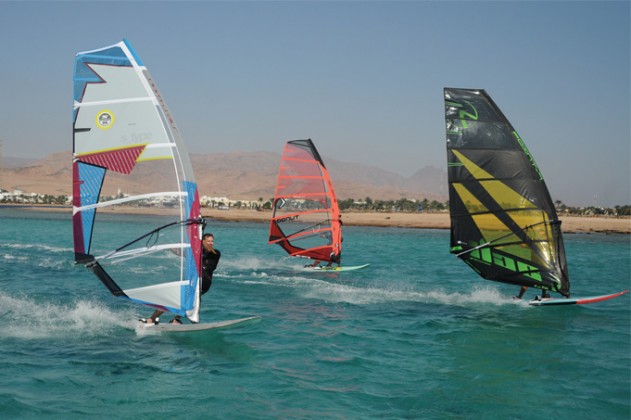2013 TWIN-CAM FREERACE SAILS TEST REVIEW REPORTS
Moving on from the recent 2013 7.0 Multi-Cam racing sails test, we now present our findings on the latest Twin-Cam Freeride/Freerace sails on the shelves.
Twin-Cam sails are designed to deliver a combination of high power and performance with easy handling and hassle free rigging.
WING COMMANDERS
With Freeride sails there is always the question of whether cams are necessary or if ‘Rotational Asymetric Foil’ (RAF or rather, as we tend to say these days, just ‘Rotational’) sails are better. While rotationals will usually be slightly lighter and offer easier handling, cams will deliver a more stable wing with a wider wind range and therefore greater blasting potential. So it depends what your freeriding focus is – so bear in mind cambered sails are, broadly speaking, less throwabout and manoeuvrable if you want to do tricks or jumps – but certainly in the larger sizes (over 7.5m) a couple of cams are fully recommended.
TARGET CUSTOMER
Twin-Cams are aimed at any rider looking for racing-style performance but in a much easier-to-handle package. They are far more user friendly than race sails and also deliver a step up in pace and control compared to nearly all rotational sails – not to mention much easier rigging. Twin-Cams are therefore excellent for gustier, say inland locations, perfect for coastal cruising in summer seabreezes and for entry-level racing or GPS Speedsailing competition.
TESTING
You can read more about our chosen location in Dahab (Egypt) in the board test intro, but while on test we experienced some perfect conditions (15-30 knots with flat water, swell and chop) to test these sails fully and push their wind ranges to the extreme at either end of the scale. We had a broad selection of boards to plug these sails into from freerides, freestyle-waves to full-on slalom boards and our test team also consisted of riders with varying sizes and riding styles, so we really got to examine these sails from every angle to gather valuable feedback.
RIGGING
Rigging a Twin-Cam sail can be a little trickier and will never be quite as quick as rigging a rotational, but to match their target user these sails are all designed to be as hassle free as possible. It’s always worth checking out the manufacturers’ rigging guides and there are usually some very useful tuning tips there too.
Here’s a few general tips on how to rig cambered sails successfully
Sleeve the mast, without engaging the cams
Apply minimum down-haul and attach the boom
Apply full outhaul
Undo cam zips if fitted
Push the cams into place
Zip-up the pockets to prevent water flooding sleeve
Downhaul fully and make final tweaks
Some narrower sleeved sails often just let you slide the cams on directly and smoothly.
MASTS
Choosing the correct mast is always a critical factor for how your sail will work and we’d always checking the manufacturers requirements for each particular sail. It’s also advisable to go for the highest carbon content that your budget will extend to as the better the mast, the better the performance your sail will deliver. All of the sails in this test were rigged on high spec masts that were all between 75-100% carbon content. Read on to see which of these will suit you best!
THE LINE-UP
GAASTRA COSMIC 8.0
NAISH INDY 7.5
NORTH S-TYPE 7.8
POINT-7 ACK 3G 7.8
SEVERNE TURBO 7.5
SIMMER SCS 7.5
TUSHINGHAM LIGHTNING 7.8
TEST OVERVIEW PAGE

